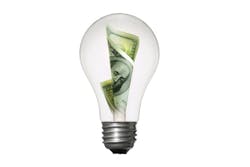There’s no getting around it: Equipment is expensive, and operating costs aren’t cheap either. An energy efficiency check-up can help you keep your overhead costs lean.
Auditing your equipment, says Don Putney, president of Elgin, Ill.–based Collision Equipment Experts, can reveal technical problems and inefficiencies, provide ideas for upgrades to slash your shop’s energy consumption, and reduce equipment wear and tear. That, says Putney, who specializes in equipment energy audits, is increasingly important as the cost of energy continues to rise.
Audited Improvements
Putney says collision repair shops often spend a lot of money on energy that isn’t necessary. Energy auditors can help you find those areas.
Shops can conduct equipment energy audits in two ways, Putney says. First, check with your utility company. Some states have programs that offer audits as a free service to business owners.
—James Cooley, owner, Advanced Collision Inc.
Alternatively, countless third-party companies offer the service. And at $200 per inspection, they’re not terribly expensive. (Visit the U.S. General Services Administration website to view a list of energy auditors across the country.) When choosing an energy auditor, make sure they’re familiar with how to assess collision shop equipment.
Putney, who recommends annual audits, highlights a few pieces of equipment energy auditors will inspect, and a couple shop improvements they will likely suggest to deliver the most noticeable cost-savings to collision repair facilities:
The equipment: Air compressor
Benefit: A frequency drive will start your compressor’s motor more gently, which will considerably reduce your facility's electricity use. It will also reduce wear and tear on the motor, increasing its lifespan.
Cost: $2,000 to $2,500
Estimated return on investment: The typical ROI is less than one year, depending on your shop’s size and type of compressor.
The equipment: Spray booth
Typical inefficiency:Spray booth motors use a huge amount of energy when starting up. They also circulate air too fast when they’re not in use.
Benefit: In economy mode, the spray booth moves half the amount of air when you’re not spraying compared to when you are, which requires 50 percent less energy. The control panel will automatically detect when you begin spraying and speed up the frequency drive accordingly. The control panel slows the air speed again when it detects five minutes of inactivity.
Cost: $7,500
Estimated return on investment: Generally, this upgrade reduces spray booth operating costs by roughly 30 percent. The ROI is two years or less. The ROI will be quicker if you have an older, indirect-fired booth because those are less efficient than direct-fired booths.
The equipment: Air acceleration for the spray booth
Typical inefficiency: Slow air speeds require paint jobs to bake longer.
Benefit: Air acceleration equipment causes the booth to act like a convection oven. It reduces cure and flash times for solvent products by 25 to 30 percent.
Cost: $7,500 to $13,000
Estimated return on investment: Three years
The equipment: Lighting
Benefit: This lighting uses electronic ballasts, which lead to significant energy savings. You also obtain much brighter light, and they are not hazardous waste material.
Cost: $100 per fixture
Estimated return on investment: The ROI is less than three years. The ROI will be less than one year if you currently have metal halide lights, because T5 and T8 fluorescent tubes use 360 fewer watts.
Plan for Upgrades
These are just a few changes your shop could make to improve equipment efficiencies—your auditor may reveal many more.
Of course, finances are always an issue to make it happen. Although these upgrades eventually pay for themselves through cost reductions, you might not have the cash up front for every investment.
Putney suggests making one improvement at a time—starting with the paint booth. That’s the biggest energy consumer in shops, and the area of biggest financial return after making improvements.
Be sure to capitalize on every incentive and rebate program available to make upgrades more affordable. James Cooley, owner of Advanced Collision Inc. in Attica, N.Y., recently made lighting and compressor upgrades to his facility. Rebates were available to him through both the state of New York and the utility company, National Grid, which conducted an energy audit for Cooley for free. Cooley received $2,000 in rebates for his $15,000 compressor purchase, and a $3,500 rebate for his $5,500
lighting upgrade.
“Collision repair is a wasteful industry; there’s no sugar-coating that,” Cooley says. “Shops need to do their part in reducing the waste of resources. You can have energy audits done at virtually no cost, and there are many financial benefits available for making certain upgrades.”
Visit the U.S. Department of Energy’s database of state incentives for renewables and efficiency at dsireusa.org for incentives available in your state.



